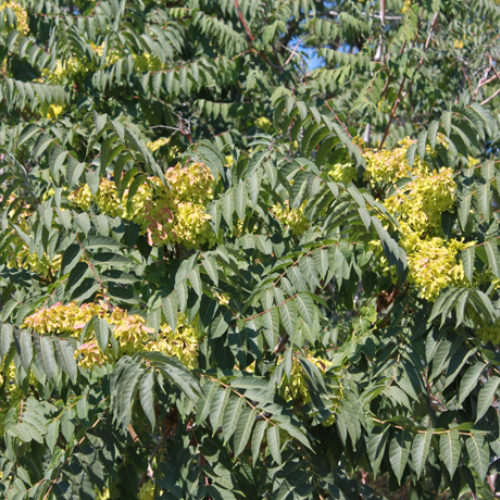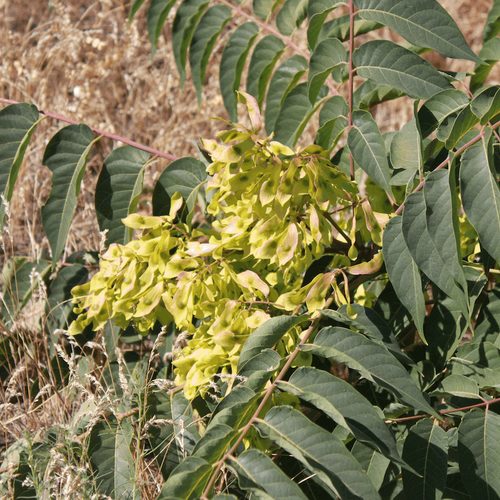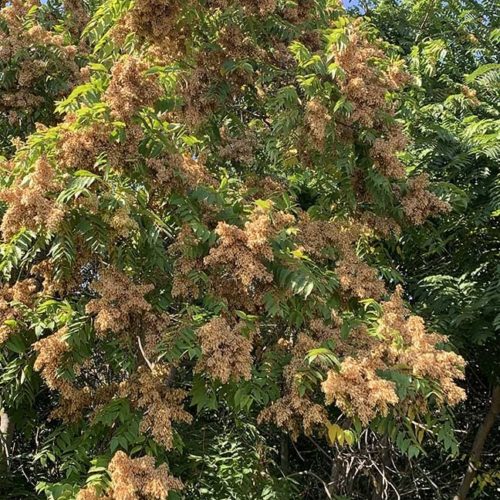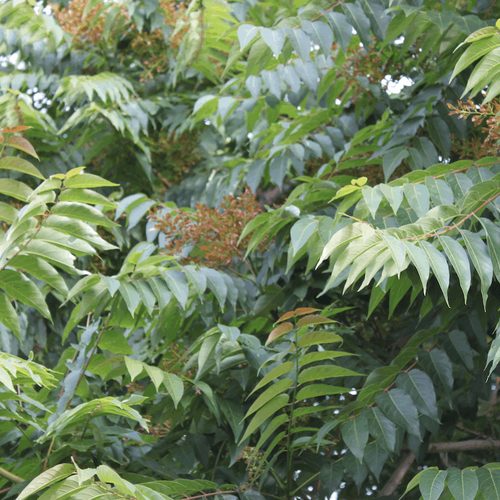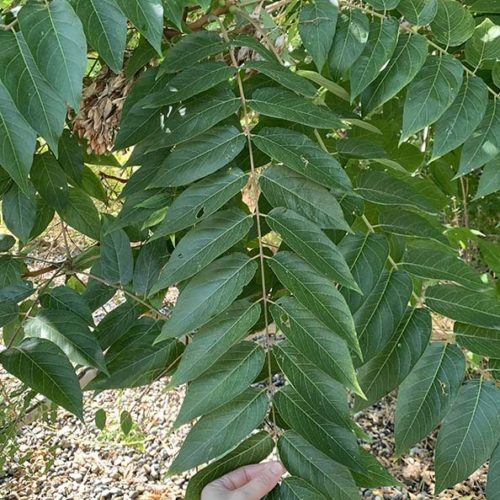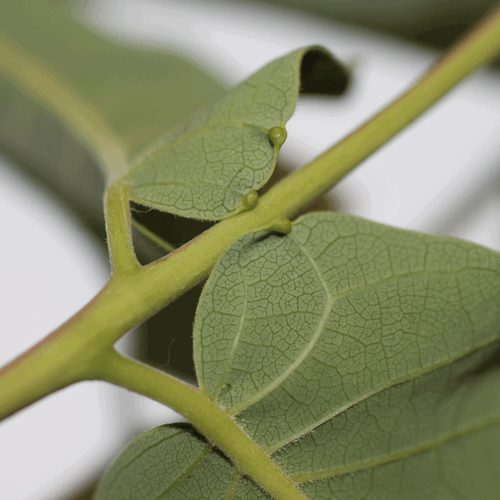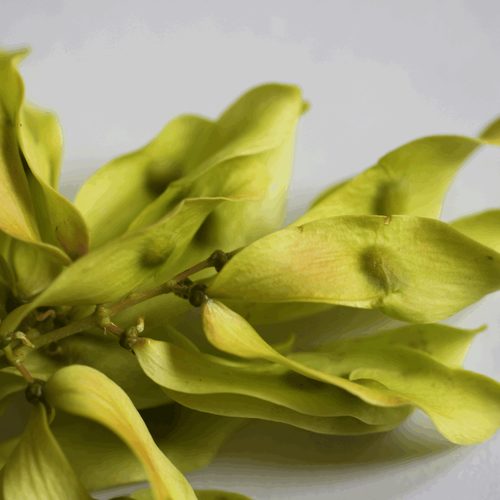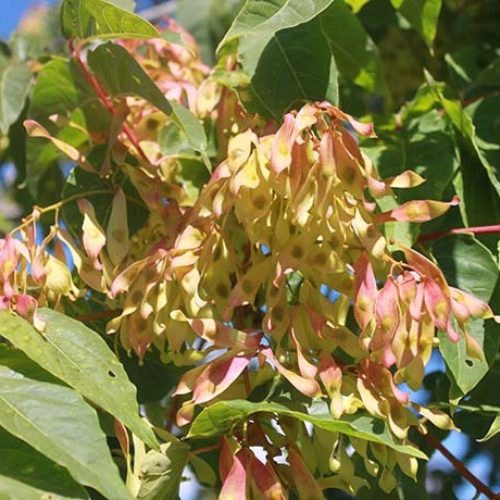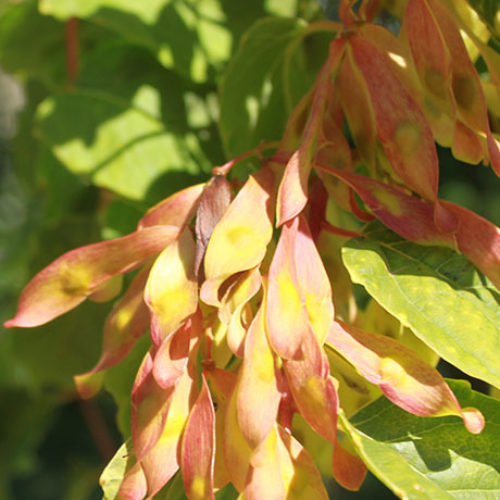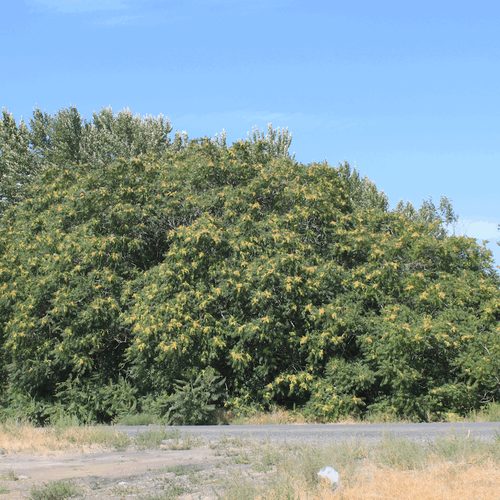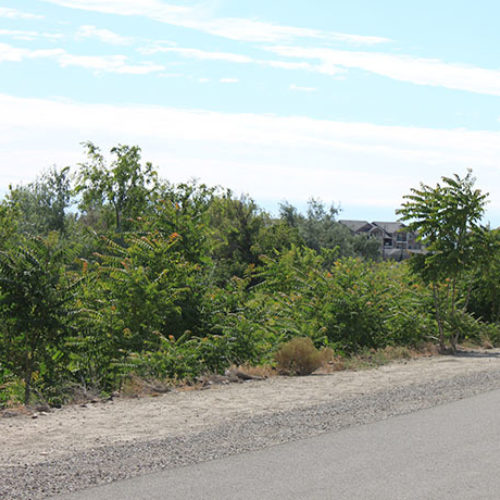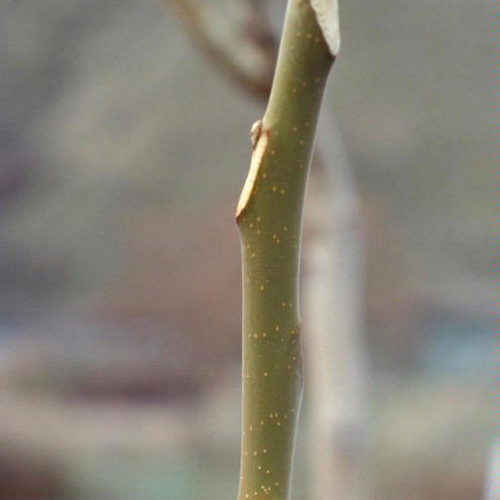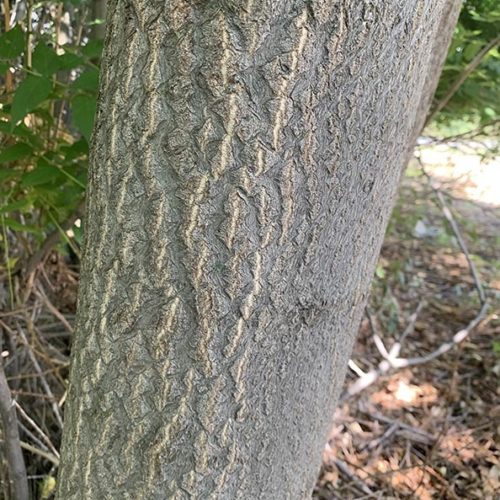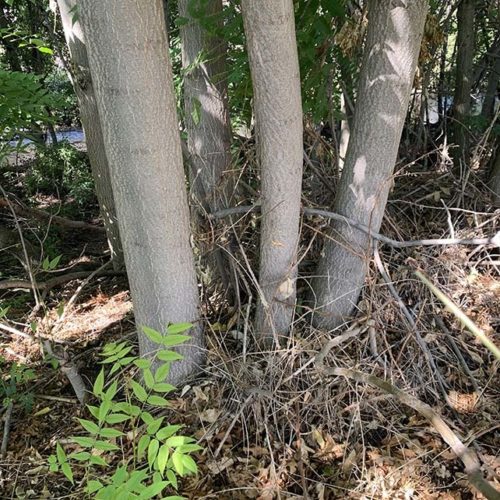Tree-of-Heaven
Ailanthus altissima
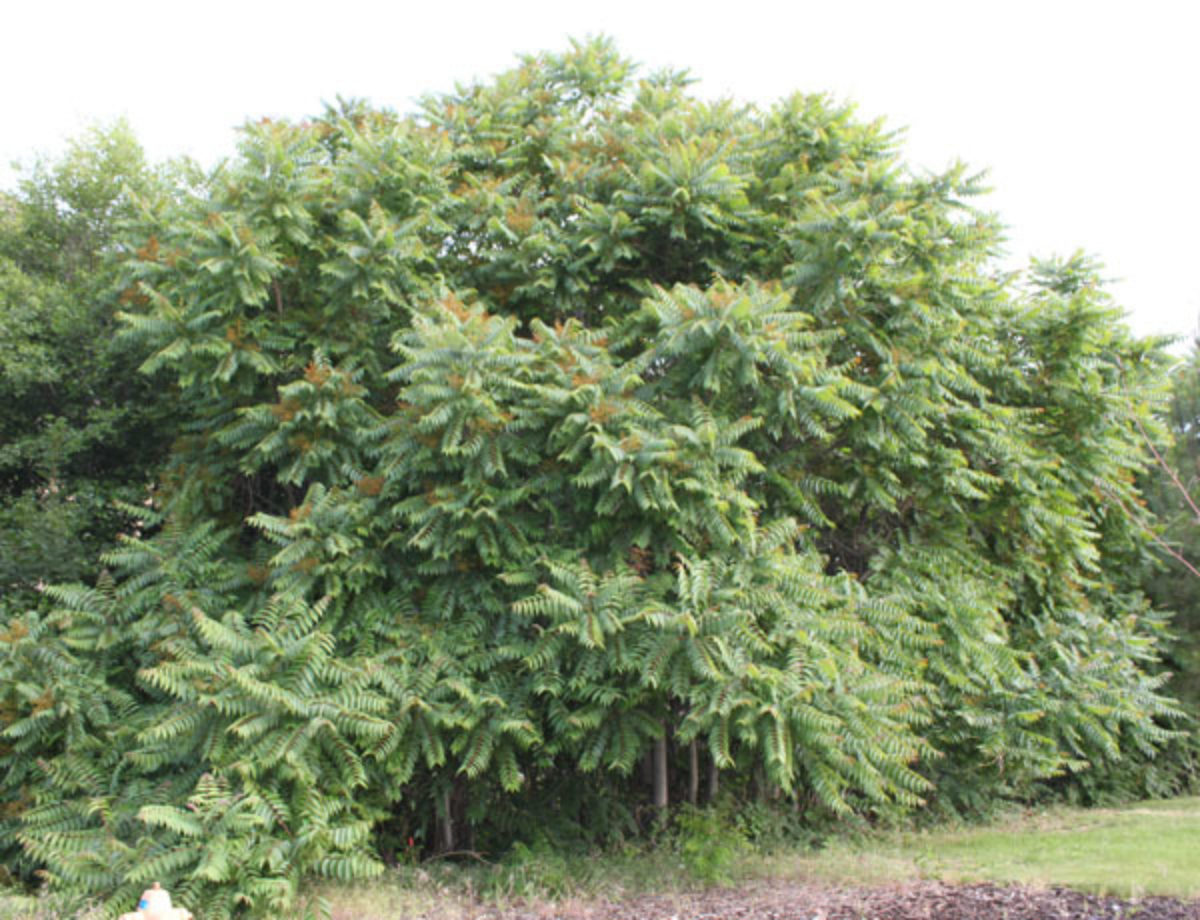
Family: Simaroubaceae
Other Common Names: stinking quassia, copal-tree
Weed class: C
Year Listed: 2012
Native to: China and Taiwan
Is this Weed Toxic?:
Certain sensitive individuals have found contact with plant parts to cause skin irritation and rashes.
Legal listings:
This plant is also on the Washington State quarantine list. It is prohibited to transport, buy, sell, offer for sale, or distribute plants or plant parts of quarantined species into or within the state of Washington or to sell, offer for sale, or distribute seed packets of seed, flower seed blends, or wildflower mixes of quarantined species into or within the state of Washington. Please see WAC 16-752 for more information on the quarantine list. For questions about the quarantine list, contact the Washington State Department of Agriculture's Plant Services Program at (360) 902-1874 or email PlantServices@agr.wa.gov.
Why Is It a Noxious Weed?
Tree-of-heaven is naturalized throughout Washington. It is a fast growing tree, forming thickets that outcompete native plants. It leaches a variety of allelochemicals into the soil that have demonstrated inhibitory or toxic effects on neighboring plants. It is also noted as being a preferred host for the spotted lanternfly, an insect that could damage many crops in Washington if it were able to establish here. Scroll down to find information about this invasive insect.
How would I identify it?
General Description
It is a deciduous tree that grows to heights 60 feet (though sometimes larger). Trees have compound, alternate leaves and clusters of male or female flowers. Plant parts have a distinct pungent peanut-butter or popcorn smell.
Flower Description
Male and female flowers are in clusters on separate trees. Clusters are terminal (at stem tips) and are larger when having male flowers. Flower clusters may be up to 12 inches wide. Flowers are light green to yellow and small, about 1/4 to 1/3 inch wide.
Leaf description
Leaves are alternate and compound, made up of 10-27 (sometime up to 45) leaflets. Leaflets with smooth edges except few rounded teeth at with large gland on underside. Terminal leaflets may have 1-2 enlarged lobes. Leaf petioles 2.75 to 5.1 inches long.
Stem description
Young branches are chestnut brown to yellow-brown. Leaf scars are large and heart to shield shaped. Bark on older stems is smooth and gray, and can form shallow diamond-shape fissures as it ages.
Fruit Seed Description
Fruit is a samara—a single seed, centrally placed in a papery wing that is loosely twisted. Size ranges from around 1.5 to 2 inches long by 0.4 to 0.6 inch wide. The color at maturity varies from greenish yellow to reddish brown.
May Be Confused With
Other trees and shrubs with compound leaves may be confused with tree-of-heaven, but have traits to easily tell them apart.
- Smooth sumac (Rhus glabra) is a native, large woody shrub, growing up to only ~10 feet tall. While its leaves are alternate and compound, leaflets have toothed (serrated) margins and no glands at the base of each leaflet. The flowers are in dense, upright clusters at stem tips, with male and female flowers on separate plants. The fruits are small, dry, hairy red fruits (drupes). In Washington, smooth sumac is native east of the Cascade Mountains. See the UW Herbarium image database and the Oregon Landscape Plants website for more information.
- Staghorn sumac (Rhus typhina), is another species of sumac that is not native to Washington State but is planted in ornamental landscapes. This large spreading shrub or tree typically grows up to ~15 feet to 20 feet. While its leaves are alternate and compound, leaflets have toothed (serrated) margins and no glands at the base of each leaflet. The new growth is notably densely hairy (like a staghorn). Fall leaf color yellow, orange or red. The flowers are in dense, upright clusters at stem tips, with male and female flowers on separate plants. The fruits are small, dry, hairy red fruits (drupes). See the UW Herbarium image database and the Oregon Landscape Plants website for more information.
See the Oregon Landscape Plants website from Oregon State University to learn about other sumac species that are used in landscapes.
- Black walnut (Juglans nigra) is a tall, non-native tree with brown to gray-black bark with narrow, deep furrows. While its leaves are alternate and compound, leaflets have toothed (serrated) margins and no glands at the base of each leaflet. Male flowers are in hanging catkins.The fruit is a round, hairless greenish husk surrounding a walnut, ~1.5 to 2 inches in diameter. Black walnut is planted in landscapes and in scattered locations across Washington State where it has escaped cultivation. See the UW Herbarium image database and the Oregon Landscape Plants websitefor more information.
See the Oregon Landscape Plants website from Oregon State University to learn about other walnut species that are used in landscapes.
Where does it grow?
It grows in a variety of habitats, from open sites into more shaded areas by vegetative growth. It can commonly be found along forest edges, woodlands, fence rows, roadsides, railroad embankments, old fields, and urban parks. Click here to see a county level distribution map of tree-of-heaven in Washington. Please note, we are currently looking for distribution information on tree-of-heaven to help strategize control efforts due to the potential introduction of spotted lanternfly. Report locations of tree-of-heaven by:
- Downloading and reporting on the Washington Invasive Species Council's Application on iPhone or Android phones or on their web form.
- Downloading and reporting on the EDDMapS West Application for iPhone or Android phones or on their web form.
- Contacting your local county noxious weed control board.
How Does it Reproduce?
Plants can reproduce by seed as well as vegetatively by roots and stump sprouts. Cut branches and trees can also form roots when left on moist ground.
How Do I Control It?
General: Whenever possible, control tree-of-heaven as seedlings or young plants, prior to the development of their extensive roots. Do not leave cut stems and stumps on moist soils as they may resprout. Check with your county noxious weed control board about disposal options. When necessary, prioritize the control of female trees to prevent further seed production and spread. Contact with plant parts has been reported to cause skin irritation and rashes to sensitive individuals, so make sure to wear gloves and protective clothing.
Manual: Seedlings and small plants can be hand-pulled, dug up, or pulled with a weed levering tool. This is best done when the soil is moist. Make sure to remove the roots as remaining fragments can resprout. Cutting or mowing plants alone will not control tree-of-heaven since stumps and roots will readily resprout.
Cultural: Creating a dense canopy of desirable plants can shade out and discourage tree-of-heaven seedling germination and establishment.
Herbicide: There are a number of systemic herbicides and application methods that can be used to control tree-of-heaven. Timing of treatment is important for success. Foliar spray should be applied to seedlings and small plants when leaves are fully emerged, from mid to later growing season. For larger plants, treatments such as application around the lower tree base (basal bark treatment), frill cuts, or stem injection provide best results when applied from mid-summer to early fall. Resprouts or suckering may occur after some treatments, such as cut-stem treatments, so make sure to monitor treated trees and perform further control treatments when necessary. The book "Weed Control in Natural Areas in the Western United States" provides herbicide and control information on tree-of-heaven, contact your county noxious weed control board for advice and site specific information. Make sure to monitor the area multiple times a year, for multiple years, and control for tree-of-heaven seedlings and resprouts. Plant the area with native and/or non-invasive plants to provide competition and to prevent other weeds from establishing.
For More Information
See our Written Findings for more information about tree-of-heaven (Ailanthus altissima).
Report on tree-of-heaven from the book "Weed Control in Natural Areas in the Western United States"
Columbia Gorge Cooperative Weed Management Area information on tree-of-heaven
New! See our brochure on tree-of-heaven and spotted lanternfly. Request copies by filling out our online survey request form here.
Information on spotted lanternfly (Lycorma delicatula)
Spotted lanternfly is an invasive insect introduced from Asia that could damage many crops in Washington if it were able to establish here. Currently, it has only been found in the northeastern United States and not yet in Washington. But, spotted lanternfly could easily be introduced to Washington in a number of ways including hitching a ride on railroad cars, in airplane cargo, or on other vehicles or equipment brought here from infested areas. Spotted lanternfly has one generation each year, with adults present starting around July through the fall. Adults are around 1 inch long and 1/2 inch wide when at rest. Click on the following descriptions to see the life stages of spotted lanternfly:
- Adults on tree bark and another example of adults on tree bark
- Side view of adult with spotted wings
- Adult with spread wings, showing red coloring on its hindwings
- Fourth stage nymph with red coloring on tree-of-heaven leaf
- Fourth nymphal stage and adults on tree-of-heaven bark
- Early nymphal stage with black and white coloring
- Cluster of early stage nymphs
- Egg mass on tree trunk
- Egg masses on metal post
- Egg masses on railing
What do I do if I find spotted lanternfly?
Report any sightings of spotted lanternfly by one of the following ways:
- Contact the Washington State Department of Agriculture's pest program: pestprogram@agr.wa.gov
- Download and report on the Washington Invasive Species Council's Application on iPhone or Android phones or on their web form.
- Download and report on the EDDMapS Application for iPhone or Android phones or on their web form.
Click on these link to learn more about spotted lanternfly
USDA APHIS information on spotted lanternfly, including video and other links
USDA Pest Alert information about spotted lanternfly also available in Spanish
Our brochure on tree-of-heaven and spotted lanternfly. Request copies by filling out our online survey request form here.
Washington Invasive Species Council information on spotted lanternfly.



